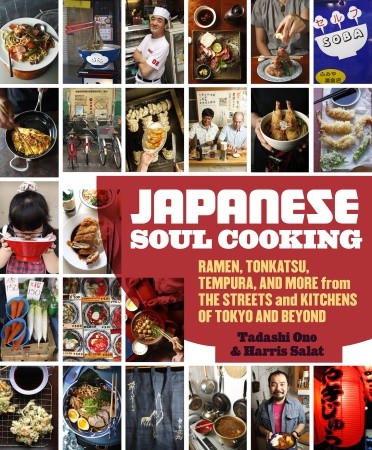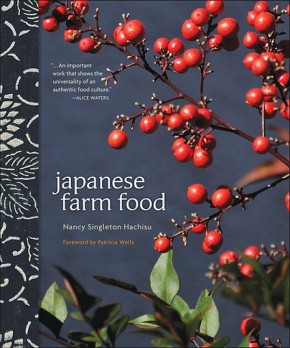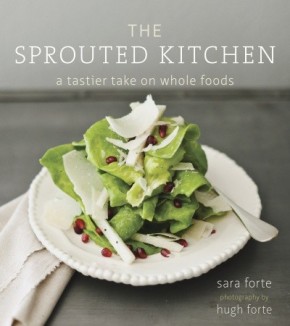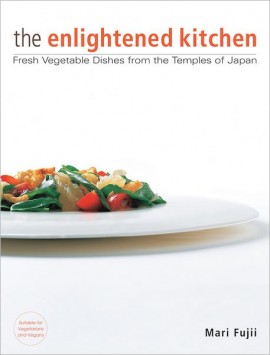Japanese Soul CookingRamen, Tonkatsu, Tempura, and More from the Streets and Kitchens of Tokyo and Beyond
A collection of more than 100 recipes that introduces Japanese comfort food to American home cooks, exploring new ingredients, techniques, and the surprising origins of popular dishes like gyoza and tempura.
Move over, sushi.
It’s time for gyoza, curry, tonkatsu, and furai. These icons of Japanese comfort food cooking are the dishes you’ll find in every kitchen and street corner hole-in-the-wall restaurant in Japan—the hearty, flavor-packed dishes that everyone in Japan, from school kids to grandmas, craves.
In Japanese Soul Cooking, Tadashi Ono and Harris Salat introduce you to this irresistible, homey style of cooking. As you explore the range of exciting, satisfying fare, you may recognize some familiar favorites, such as ramen, soba, udon, and tempura. Others are lesser known Japanese classics—such as wafu pasta (spaghetti with bold, fragrant toppings like miso meat sauce), tatsuta-age (fried chicken marinated in garlic, ginger, and other Japanese seasonings), and savory omelets with crabmeat and shiitake mushrooms—that will instantly become standards in your kitchen as well. With foolproof instructions and step-by-step photographs, you’ll soon be knocking out chahan fried rice, mentaiko spaghetti, saikoro steak, and more for friends and family.
Ono and Salat’s fascinating exploration of the surprising origins and global influences behind popular dishes is accompanied by rich location photography that captures the energy and essence of this food in everyday Japanese life, bringing beloved Japanese comfort food to Western home cooks for the first time.
Tadsahi Ono is the executive chef of Matsuri in New York City. He has been featured in the New York Times, Gourmet, and Food & Wine.
Harris Salat writes about food and culture for the New York Times, Saveur, and for his blog, The Japanese Food Report (www.japanesefoodreport.com). He is the author, with Takashi Yagihashi, of Takashi’s Noodles. Together, Ono and Salat are the authors of Japanese Hot Pots.
“This is the book on Japanese cooking I have been waiting for without knowing it! Tadashi and Harris have compiled a wonderful collection of recipes that veers sharply from the mysterious and lofty world of sushi and kaiseki and lands smack dab in the home kitchen, telling a great story of foreign culinary traditions colliding with traditional Japanese technique along the way.”
—Andy Ricker, chef-owner of Pok Pok
“Sushi? Bah! Japanese food is so much more than raw fish, and this book is a joyful (and useful!) exploration of the earthy, fatty, meaty, rib-sticking, lip-smacking fare—the noodles and curries and deep-fried delights—that millions of Japanese depend on every day. I get hungry just thinking about it.”
—Matt Gross, editor, BonAppetit.com
“Tadashi Ono and Harris Salat bring to mouthwatering life a fascinating story: how Western influences opened up a nation’s taste buds and created a new Japanese cuisine of modern comfort food classics. Anyone obsessed with a steaming bowl of ramen, light-as-air tempura, or the perfect gyoza will find that there’s all that—and more—right here, just waiting to be cooked and devoured.”
—Joe Yonan, author of Eat Your Vegetables and food and travel editor of the Washington Post
KAMO NANBAN SOBA
SESAME CHICKEN
KAMO NANBAN SOBA
 This is one of our very favorite dishes, soba in hot broth served with tender slices of duck breast. It’s accented with wasabi, which just pops the flavor of the bird. Amazing. Be sure to prepare the duck breast tender and rare; otherwise, it’ll become tough and tasteless if overcooked. Keep in mind, too, that the duck will cook slightly more in the hot soup, another reason to keep it rare. You’ll see that we sauté the negi in this dish in duck fat, which adds even more incredible flavor to the soba.
This is one of our very favorite dishes, soba in hot broth served with tender slices of duck breast. It’s accented with wasabi, which just pops the flavor of the bird. Amazing. Be sure to prepare the duck breast tender and rare; otherwise, it’ll become tough and tasteless if overcooked. Keep in mind, too, that the duck will cook slightly more in the hot soup, another reason to keep it rare. You’ll see that we sauté the negi in this dish in duck fat, which adds even more incredible flavor to the soba.
Serves 4
6 cups dashi (page 161)
3⁄4 cup kaeshi (page 162)
6 tablespoons mirin
2 duck breasts (about 1 1⁄2 pounds total)
Salt
2 negi (see page 235), white parts only, sliced into 1 1⁄2-inch pieces
4 servings soba (see page 162)
1⁄4 cup thinly sliced negi or scallion
4 teaspoons wasabi
Shichimi togarashi (see page 234)
To prepare the hot soba broth, add the dashi, kaeshi, and mirin to a saucepan and bring to a boil over high heat. Remove from the heat and set aside.
To prepare the duck, trim off excess fat from the duck breasts. Cut crisscross notches about 1/8 inch deep into the duck’s skin, so the skin doesn’t shrink when cooking and the layer of fat under the skin renders easier. Season the duck with salt on both sides.
Preheat a dry skillet over medium heat. Lay the duck breasts in the skillet, skin side down. Cook for about 2 minutes, until the skin browns and fat begins to render. Turn the duck, and reduce the heat to low. Cook for 3 more minutes and turn again, so the skin side is again down. Cook for 2 minutes and transfer the duck to a cutting board. The duck will be cooked rare.
Pour out the fat that has accumulated in the skillet and discard. Return the skillet to the heat. Add the 1 1/2-inch pieces negi and cook for about 1 minute, until the negi caramelizes slightly. Transfer to a plate.
Thinly slice the duck, and set aside.
Cook the soba (see page 162).
Add the duck slices and negi to the broth. Return the broth to a boil over medium heat. Turn off the heat.
Divide the soba noodles among 4 bowls. Use a ladle to pour the broth over the soba. Use chopsticks or tongs to pick up the duck slices and negi from the saucepan, and arrange them over the soba. Garnish each bowl with about 1 tablespoon sliced negi and 1 teaspoon wasabi. Season with shichimi togarashi, to taste.
SESAME CHICKEN
Instead of flour or potato starch, here we coat marinated chicken with sesame seeds. When deep-fried, the chicken comes out tender and juicy, but it’s the sesame seeds—browned, nutty, and incredibly fragrant—that put this dish over the top. Use raw sesame seeds if you can find them.
Serves 4
1 pound boneless chicken breast, cut into 1-inch cubes
1⁄2 teaspoon salt
4 teaspoons grated ginger
1⁄4 cup sake
1⁄4 cup soy sauce
2 tablespoons mirin
1⁄2 cup sesame seed (preferably raw, but you can use toasted sesame seed, too)
Vegetable oil for deep-frying
Steamed rice, for serving
Mix together the chicken, salt, ginger, sake, soy sauce, and mirin in a bowl until well combined. Marinate the chicken for 15 minutes.
In another bowl, add the sesame seed. When the chicken is ready, squeeze excess marinade from the chicken with your hands and dredge each piece in the sesame seed, coating both sides well. Place the coated chicken pieces on a plate.
Place a cast-iron skillet on a burner. Fill the skillet with vegetable oil to a height of at least 1 inch. Attach a deep-fry (or “candy”) thermometer to the side of the skillet. On a work surface near the skillet, set up a tray lined with newspaper or paper towels to drain the cooked sesame chicken. Turn the heat on to high. Heat the oil to 340°F.
When the oil has heated to 340°F, add the chicken to the skillet. Depending on the size of the skillet, cook the chicken in batches. Be careful not to overfill the skillet, which will lower the cooking temperature; use, at most, half of the surface area of the oil to cook. While the chicken is frying, check the oil temperature with a candy thermometer. Regulate the heat to maintain a constant 340°F oil temperature. If the oil is too hot, the chicken will burn; if too low, the chicken will come out soggy and greasy.
Fry the chicken for about 4 minutes, until the chicken turns golden brown. Be careful that the sesame seed doesn’t burn. When it’s ready, transfer the chicken to the paper-lined plate to drain. Serve piping hot with steamed white rice on the side.
Reprinted with permission from Japanese Soul Cooking by Tadashi Ono & Harris Salat, copyright © 2013. Published by Ten Speed Press, a division of Random House, Inc.
Photography: Todd Coleman © 2013












Leave a Reply